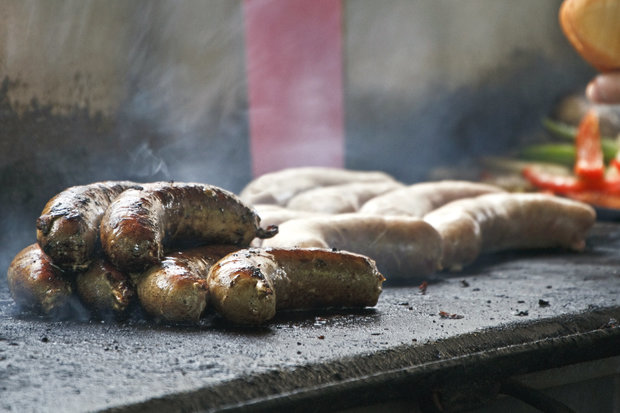LINCOLN SQUARE — The German-American Fest is here, heralding the launch of Oktoberfest season in Lincoln Square, and with it comes the great annual debate: Bratwurst or thuringer? Thuringer or bratwurst?
Turns out, that's a trick question.
A thuringer — or if you want to get technical about it, a Thüringer Rostbratwurst — is a brat.
There are more than 40 regional variations of bratwurst in Germany. They share a common foundation of pork, veal or beef, but differ in myriad ways, from the coarseness of the grind to the seasonings, from their length to the manner in which they're eaten.
 Bratwurst [Flickr/Ian Sane]
Bratwurst [Flickr/Ian Sane]
Like your sausage made with blood? Order up a a blutwurst. Looking for something snack-sized? Try the nürnberger, about as big as a finger and served in multiples of six or 12.
Better yet, let's see you eat a weisswurst (white sausage) like a true Bavarian — meat sucked out whole, no fork or knife required.
But it's the thuringer (sometimes seen spelled thueringer) that reigns supreme, and that's saying something in Germany, which boasts a national Bratwurst Museum.
 Thuringer. [Wikimedia Commons]
Thuringer. [Wikimedia Commons]
Named for the Thuringia region, Thuringer sausage date to the 1400s. It's distinguished, according to German purity food laws, by its length — 6 to 7 inches — a medium-fine grind, low fat content and a distinctive blend of spices heavy on the marjoram and garlic.
All of this begs the question: When you order up a plain old bratwurst, what exactly are you getting?
According to Derek Luszcz, who along with his sister Yolanda owns Gene's Sausage Shop, what most Americans think of as a brat is a version of the Sheboygan sausage, invented in Wisconsin.
"It sort of became the generic," he said.
Recipes for the Sheboygan abound online. Typical spices include salt, pepper, celery seed, nutmeg, ginger and marjoram. Boiling in beer is highly recommended.
Gene's, 4750 N. Lincoln Ave., sells more than a dozen kinds of bratwurst, including several variations on the Sheboygan: the Chicago brat is a Sheboygan with cheddar, the Swiss brat is a Sheboygan with emmentaler, and the Hungarian brat is a Sheboygan with hot paprika.
All of Gene's sausages are made on-site out of actual cuts of meat like pork shoulder, stuffed in natural hog casings and hand-tied the old-fashioned way.
During the summer, Gene's doubles the space devoted to brats in its meat cases, selling as much as 2,500 pounds a week.
What makes brats so popular?
"I think it's the simplicity of cooking them," Luszcz said.
He added that, with the right equipment, sausage is also quite easy to make.
Before you ask, yes, Luszcz is well aware of the cliche that sausage-making is best not seen.
"It's not as bad as you think," he said.
Get your Thuringers and brats at German-American Fest, which runs Friday through Sunday at Lincoln and Leland avenues. Hours are 5-11 p.m. Friday, noon to 11 p.m. Saturday, and noon to 10 p.m. Sunday.
For more neighborhood news, listen to DNAinfo Radio here:

























